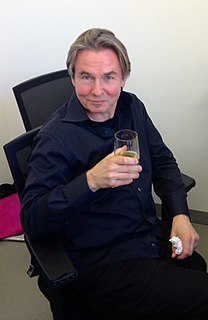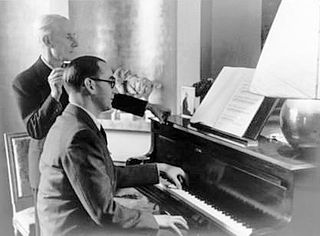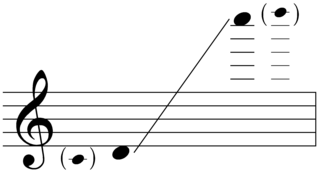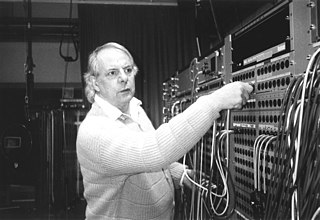EXPO is an orchestral composition by the Finnish composer Magnus Lindberg. It was the first work commissioned by the New York Philharmonic under the conductor Alan Gilbert, and was Lindberg's first commission as the orchestra's composer-in-residence. The piece was first performed on September 16, 2009 at Avery Fisher Hall, New York City, during Alan Gilbert's inaugural concert with the New York Philharmonic. EXPO was the first newly commissioned work to open the New York Philharmonic's concert season since the premiere of Aaron Copland's Connotations under Leonard Bernstein on September 23, 1962.

Esa-Pekka Salonen is a Finnish orchestral conductor and composer. He is principal conductor and artistic advisor of the Philharmonia Orchestra in London, conductor laureate of the Los Angeles Philharmonic, and music director-designate of the San Francisco Symphony.
On the Transmigration of Souls is a composition for orchestra, chorus, children's choir, and pre-recorded tape by the American composer John Adams. It was commissioned by the New York Philharmonic and Lincoln Center's Great Performers shortly after the September 11 terrorist attacks of 2001. Adams began writing the piece in late January 2002, and the music was premiered by the New York Philharmonic on September 19, 2002 at Avery Fisher Hall. The work is composed in a single movement and has a duration of approximately 25 minutes. Its sheet music is published by Boosey & Hawkes.
The Piano Concerto is a concerto for solo piano and orchestra in three movements by the Finnish composer Esa-Pekka Salonen. The work was jointly commissioned by the New York Philharmonic, the BBC, the NDR Symphony Orchestra, and Radio France. It was premiered February 1, 2007 in Avery Fisher Hall, New York City, with Salonen conducting the pianist Yefim Bronfman and the New York Philharmonic. Salonen dedicated the piece to Yefim Bronfman.
The Clarinet Concerto is a composition for solo clarinet and orchestra by the Finnish composer Magnus Lindberg. It was written for the Finnish clarinetist Kari Kriikku. The piece was given its world premiere in Finlandia Hall, Helsinki, on September 14, 2002 by Kari Kriikku and the Finnish Radio Symphony Orchestra under the direction of Jukka-Pekka Saraste. The composition is one of Lindberg's most frequently performed works.
The Cello Concerto No. 2 is the second cello concerto by the Finnish composer Magnus Lindberg. It was commissioned by the Los Angeles Philharmonic in June 2013 to fill the planned premiere date of Oliver Knussen's then delayed Cello Concerto. The work was first performed in the Walt Disney Concert Hall, Los Angeles, on October 18, 2013 by the Finnish cellist Anssi Karttunen and the Los Angeles Philharmonic under the direction of Esa-Pekka Salonen.
Souvenir is a composition for chamber orchestra by the Finnish composer Magnus Lindberg. The work was commissioned by the New York Philharmonic, for which Lindberg was then composer-in-residence. It was given its world premiere on November 19, 2010 at Symphony Space, New York City, by the New York Philharmonic under the direction of Alan Gilbert. The piece was written in memoriam for Lindberg's friend and fellow composer Gérard Grisey.
The Concerto for Orchestra is an orchestral composition by the Finnish composer Magnus Lindberg. The work was commissioned by the BBC and was composed between 2002 and 2003. It was given its world premiere by the BBC Symphony Orchestra under the direction of Jukka-Pekka Saraste on September 30, 2003 at the Barbican Centre, London.
The Cello Concerto No. 1 is a composition for solo cello and orchestra by the Finnish composer Magnus Lindberg. It was first performed in the Cité de la Musique, Paris on May 6, 1999 by the cellist Anssi Karttunen and the Orchestre de Paris under the direction of Esa-Pekka Salonen.
Kraft is a composition for solo ensemble, electronics, and orchestra by the Finnish composer Magnus Lindberg. The work was commissioned by the Helsinki Festival and was first performed on September 4, 1985 by the Toimii ensemble and the Finnish Radio Symphony Orchestra under the direction of Esa-Pekka Salonen. The piece was awarded the International Rostrum of Composers in 1986 and won the Nordic Council Music Prize in 1988.
Fresco is an orchestral composition by the Finnish composer Magnus Lindberg. The work was commissioned by the Los Angeles Philharmonic. Its world premiere was given in Los Angeles on March 12, 1998 by the Los Angeles Philharmonic under the direction of Esa-Pekka Salonen, to whom the piece is dedicated.
Al largo is a composition for orchestra by the Finnish composer Magnus Lindberg. It was commissioned by the New York Philharmonic while Lindberg served as the orchestra's composer-in-residence. Its world premiere was given by the New York Philharmonic under the direction of Alan Gilbert at Avery Fisher Hall on June 23, 2010.
The Violin Concerto No. 2 is a composition for violin solo and orchestra by the Finnish composer Magnus Lindberg. The work was jointly commissioned by the London Philharmonic Orchestra, the Berlin Philharmonic, Swedish Radio Symphony Orchestra, Radio France, and New York Philharmonic. Its world premiere was given by the violinist Frank Peter Zimmermann and the London Philharmonic Orchestra under the direction of Jaap van Zweden at Royal Festival Hall, London, on December 9, 2015. The piece is dedicated to Zimmermann.
Sculpture is an orchestral composition by the Finnish composer Magnus Lindberg. The music was commissioned by the Los Angeles Philharmonic with support from the Koussevitzky Music Foundation to celebrate the orchestra's inaugural season at the Walt Disney Concert Hall. Its world premiere was given by the Los Angeles Philharmonic under the direction of Esa-Pekka Salonen on October 6, 2005.
Parada is an orchestral composition by the Finnish composer Magnus Lindberg. The piece was composed for the music festival Related Rocks which celebrates the works of Lindberg and related composers. Its world premiere was given at The Anvil, Basingstoke on February 6, 2002 by the Philharmonia Orchestra under the direction of Esa-Pekka Salonen, to whom the work is dedicated.
Cantigas is an orchestral composition by the Finnish composer Magnus Lindberg. The work was commissioned by the Cleveland Orchestra and was composed between 1998 and early 1999. Its world premiere was performed in Cleveland by the Cleveland Orchestra under the direction of Christoph von Dohnányi on April 1, 1999.
Two Episodes is a composition for orchestra by the Finnish composer Magnus Lindberg. The work was commissioned by the London Philharmonic Orchestra, for which Lindberg is composer-in-residence, and co-commissioned by The Proms, the Helsinki Festival, and the Casa da Música. It was first performed by the London Philharmonic Orchestra under the direction of Vladimir Jurowski in the Royal Albert Hall, London, on July 24, 2016.
The Piano Concerto is a composition for piano and orchestra by the Austrian composer Heinz Karl Gruber. The work was commissioned for the pianist Emanuel Ax by the New York Philharmonic, the Royal Stockholm Philharmonic Orchestra, the Berlin Philharmonic, and the Tonhalle Orchester Zürich. It was composed from 2014 through 2016 and was given its world premiere by Emanuel Ax and the New York Philharmonic under the direction of Alan Gilbert at David Geffen Hall on January 5, 2017.
The Concerto for Piano and Orchestra is a musical composition by the American composer Aaron Copland. The work was commissioned by the conductor Serge Koussevitzky who was then music director of the Boston Symphony Orchestra. It was first performed on January 28, 1927, by the Boston Symphony Orchestra conducted by Koussevitzky with the composer himself as the soloist. The piece is dedicated to Copland's patron Alma Morgenthau Wertheim.










